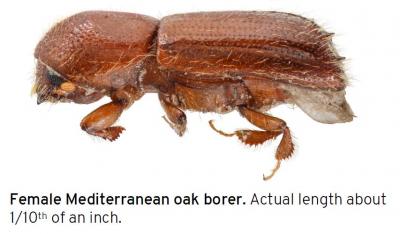Invasive Mediterranean Oak Borer Threatens Significant Wilsonville Oak Trees
September 18, 2023— Some of Wilsonville’s most majestic Oregon white oaks (Quercus garryana) are among several local trees believed to be in rapid decline because of an infestation of a pest known as Mediterranean Oak Borer (MOB).
This invasive brown “ambrosia” beetle, no larger than a thick segment of pencil lead, is a still-emerging threat to North American oaks. (In Europe, it has also been reported from elm, maple, and walnut trees, although damaging attacks have not been reported for these other tree types.)
Ambrosia beetles don’t feed directly on wood but inoculate the wood with symbiotic fungi and other microbes. While the MOB was first discovered in Oregon in 2018, the first Oregon white oak tree confirmed to have declined because of MOB infestation was identified this May, in Troutdale. The pest has also been observed in Woodburn.
The Oregon Department of Agriculture (ODA) notes that MOB and oak wilt pose a great threat to native oaks already under stress due to drought and other factors.
“There is very little science or best management practices to rely on with regard to this pest, how it operates, and how to best contain it,” said Community Development Director Chris Neamtzu. “Even the State’s agricultural science community – the Department of Agriculture, the Department of Forestry (ODF) – is still completing the process of developing its practices to identify and mitigate MOB’s presence.”
Last month in Frog Pond West, consulting arborists confirmed Oregon’s second white oak infestation, a 55-inch white oak that went into quick decline over the past year. An emergency tree permit was issued to have the tree removed in the interest of public safety. Prior to the tree’s removal, samples sent to a North Carolina laboratory by arborists from Bartlett Tree Experts were confirmed for MOB infestation.
Upon confirmation, the City immediately notified the ODA. On Sept. 8, at a field meeting with scientists from ODA, ODF, Metro and consulting arborists, additional samples were collected from the Frog Pond tree, as well as trees located near the Wilsonville Transit Center site along Barber St. and Kinsman Rd., where visual evidence suggests MOB is present.
A subsequent observation of the Three Sister Oaks on Kinsman Road by the City’s consulting arborist on Sept. 12 indicated evidence of MOB in the middle oak. Similar signs of infestation have been observed by Parks and Recreation staff and arborists in other Wilsonville trees, including the oak at just west of the Kinsman Road/Wilsonville Road intersection.
“The rapid decline of many of our precious Oregon white oaks has been unprecedented and alarming,” Neamtzu said. “Because of the sudden and rapid decline observed in several of these important trees, we have prioritized a thorough examination of the City’s oak inventory and we’re gathering new information daily to inform our aggressive mitigation and preservation efforts.”
Arborists have begun injecting insecticides and fungicides into the trunks of publicly-owned large Oregon white oak trees, and City staff is coordinating with homeowners associations and land owners to preserve trees located on private property. The ODA and ODF are also providing support for the City staff, as are consulting arborists at Bartlett Tree Experts and Morgan Holen & Associates, LLC.
The MOB is the second invasive pest to recently emerge as a significant threat to Oregon trees. The City had already begun mitigation efforts to protect trees from Emerald Ash Borer (EAB), a similarly destructive pest sighted in Washington County last year.
The ODA and ODF have developed a handout to answer Frequently Asked Questions that may help in the identification and reporting of MOB. The materials underline the importance of properly disposing wood to prevent the spread of the insect and reporting any suspicion of infested oak trees or debris. Click here to report a suspicion of MOB.
Trees are a significant part of Wilsonville’s identity; as they provide a sense of pride, a connection to our past, and serve as an important nesting and feeding habitat for many bird, small mammal and insect species. Many of the City’s most significant trees have been designated Heritage Trees.
Slow-growing, iconic Oregon white oaks, while relatively rare regionally, are featured throughout the greater Wilsonville area. City of Wilsonville planners have long sought to preserve and showcase these significant historic trees, which are visible throughout the community at many visible locations, including Wilsonville High School, SW Parkway Avenue, Kinsman Rd., and Argyle Square Shopping Center, and many of the City’s public parks and residential developments.
Additional information from the ODA is available here.
# # #





